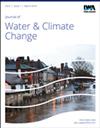利用干旱指数、遥感和机器学习技术为农业干旱监测进行早期作物产量预测
IF 3.1
4区 环境科学与生态学
Q2 WATER RESOURCES
引用次数: 0
摘要
由于干旱和极端高温等恶劣天气事件,农作物产量的不可预测性仍然是一个主要的担忧。本文对1986 - 2019年印度古吉拉特邦易旱半干旱的索拉斯特拉地区6个气象指数和3个Landsat卫星植被干旱指数进行了评价。采用多层感知(multilayer perception, MLP)、多层感知人工神经网络和随机森林(random forest, RF)技术建立棉花和花生作物产量预测模型。模型在播种后75天和播种后105天两个时间尺度下进行作物产量估算。在气象干旱指数中,选择标准化降水蒸散指数/侦察干旱指数、归一化植被异常指数/植被状况指数、归一化差异水分指数异常与作物产量相关性最高。基于rf的模型预测棉花和花生产量最有效,R2范围为0.77 ~ 0.92,纳什-苏特克里夫效率范围为71 ~ 90%,均方根误差范围为80 ~ 133 kg/ha,花生299 ~ 453 kg/ha。本研究展示了基于早期作物产量预测的若干决策方法,包括及时的干旱缓解措施。本文章由计算机程序翻译,如有差异,请以英文原文为准。
Early crop yield prediction for agricultural drought monitoring using drought indices, remote sensing, and machine learning techniques
The unpredictability of crop yield due to severe weather events such as drought and extreme heat continue to be a key worry. The present study evaluated six meteorological and three Landsat satellite-based vegetation drought indices from 1986 to 2019 in the drought-prone-semi-arid Saurashtra region of Gujarat (India). Cotton and groundnut crop yield prediction models were developed using multiple linear regression (multilayer perception (MLP)), artificial neural network with MLP, and random forest (RF). The models performed crop yield estimation at two timescales, i.e., 75 days after sowing and 105 days after sowing. The standardized precipitation evapotranspiration index/reconnaissance drought index among meteorological drought indices, normalized difference vegetation anomaly index/vegetation condition index, and normalized difference water index anomaly were chosen as best highest correlations with crop yields. The RF-based models were found most efficient in predicting the cotton and groundnut yield of Saurashtra with R2 ranging from 0.77 to 0.92, Nash–Sutcliffe efficiency ranging from 71 to 90%, and root-mean-square error ranging from 80 to 133 kg/ha for cotton and 299 to 453 kg/ha for groundnut. This study demonstrated the method for making several decisions based on early crop yield prediction including timely drought mitigation measures.
求助全文
通过发布文献求助,成功后即可免费获取论文全文。
去求助
来源期刊

Journal of Water and Climate Change
WATER RESOURCES-
CiteScore
4.80
自引率
10.70%
发文量
168
审稿时长
>12 weeks
期刊介绍:
Journal of Water and Climate Change publishes refereed research and practitioner papers on all aspects of water science, technology, management and innovation in response to climate change, with emphasis on reduction of energy usage.
 求助内容:
求助内容: 应助结果提醒方式:
应助结果提醒方式:


